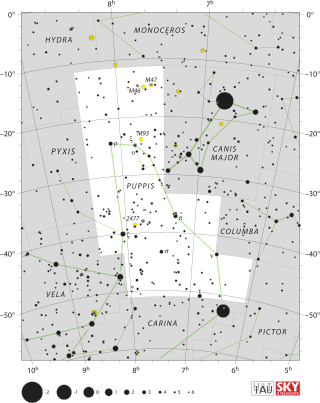Top Qs
Timeline
Chat
Perspective
Puppis
Constellation in the southern celestial hemisphere From Wikipedia, the free encyclopedia
Remove ads
Puppis ("stern") is a constellation in the southern sky. It was originally part of the traditional constellation of Argo Navis (Argo is the ship of Jason and the Argonauts), which was divided into three parts, the other two being Carina (the keel and hull), and Vela (the sails). Puppis is the largest of the three constellations in square degrees. It is one of the 88 modern constellations recognized by the International Astronomical Union.
Remove ads
History
The constellation of Argo Navis is recorded in Greek texts, derived from ancient Egypt around 1000 BC. According to Plutarch, its equivalent in Egyptian astronomy was the "Boat of Osiris".[2]
As Argo Navis was roughly 28% larger than the next largest constellation, Hydra,[3] it was sub-divided into three sections in 1752 by the French astronomer Nicolas Louis de Lacaille, including Puppis, which he referred to as "Argûs in puppi". Despite the division, Lacaille kept a single set of Bayer designations for the whole constellation, Argo. Therefore, Carina has the α, β, and ε, Vela has γ and δ, Puppis has ζ, and so on.[4] In 1844, John Herschel proposed complete dividing Argo Navis in accordance with Lacaille's divisions.[5] However, the constellation continued to be used into the 20th century, and officially received a three-letter designation alongside its divisions in 1922.[6] Puppis, along with Carina and Vela, was included in the list of modern IAU constellations in 1930.[7]
Remove ads
Features
Summarize
Perspective

Named stars
Planetary systems
Several extrasolar planet systems have been found around stars in the constellation Puppis, including:
- On July 1, 2003, a planet was found orbiting the star HD 70642. This planetary system is much like Jupiter with a wide, circular orbit and a long-period.
- On May 17, 2006, HD 69830 was discovered to have three Neptune-mass planets, the first multi-planetary system without any Jupiter-like or Saturn-like planets. The star also hosts an asteroid belt at the region between middle planet to outer planet.
- On June 21, 2007, the first extrasolar planet found in the open cluster NGC 2423, was discovered around the red giant star NGC 2423-3. The planet is at least 10.6 times the mass of Jupiter and orbits at 2.1 AU distance.
- On September 22, 2008, two Jupiter-like planets were discovered around HD 60532. HD 60532 b has a minimum mass of 1.03 MJ and orbits at 0.759 AU and takes 201.3 days to complete the orbit. HD 60532 c has a minimum mass of 2.46 MJ and orbits at 1.58 AU and takes 604 days to complete the orbit.
- In 2023, Astronomers detected two ice giant type exoplanets (both with a mass of tens of earths) having a collision event around the 300 million year old star designated as 2MASS J08152329-3859234.
Deep-sky objects

As the Milky Way runs through Puppis, there are many open clusters in the constellation. M46 and M47 are two open clusters in the same binocular field. M47 can be seen with the naked eye under dark skies, and its brightest stars are 6th magnitude. Messier 93 (M93) is another open cluster somewhat to the south. NGC 2451 is a very bright open cluster containing the star c Puppis, and the near NGC 2477 is a good target for small telescopes. The star Pi Puppis is the main component of a bright group of stars known as Collinder 135.
M46 is a circular open cluster with an overall magnitude of 6.1 at a distance of approximately 5400 light-years from Earth. The planetary nebula NGC 2438 is superimposed; it is approximately 2900 light-years from Earth. M46 is classified as a Shapley class f and a Trumpler class III 2 m cluster. This means that it is a rich cluster that appears distinct from the star field, despite not being at its center. The cluster's stars, numbering between 50 and 100, have a moderate range in brightness.[8]
Remove ads
See also
References
Sources
External links
Wikiwand - on
Seamless Wikipedia browsing. On steroids.
Remove ads

